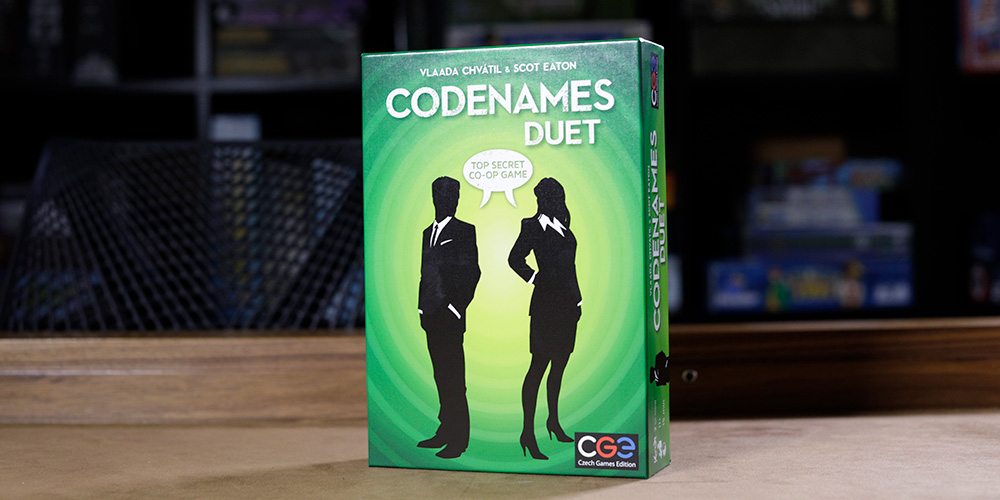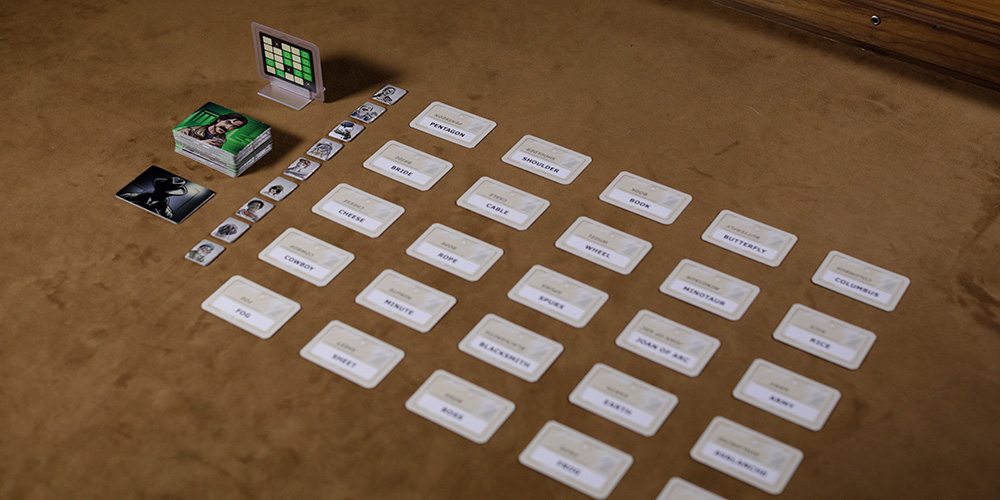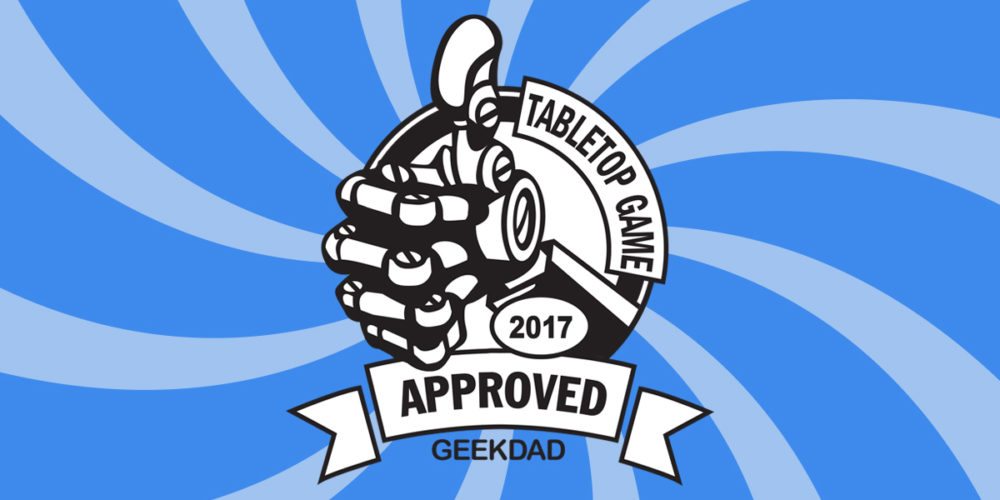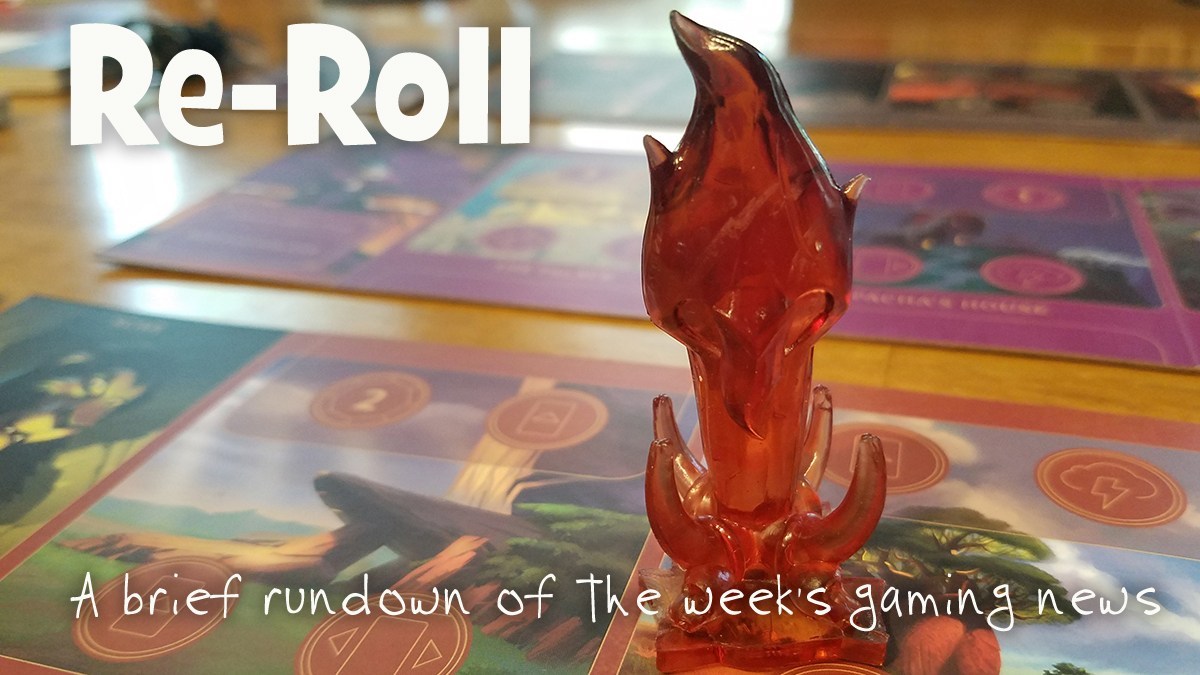
I’m a creature of habit when it comes to Gen Con. Every year, when the doors open at 10 a.m. on Thursday, you’ll find Jonathan Liu and me chatting with Ray Wehr from Calliope Games. And every year, for the last couple, at least, a Codenames game is the first one I’ve reviewed upon returning home. Why change a good thing?
What Is Codenames Duet?
Unlike previous versions of Codenames, Codenames Duet is a completely cooperative game from Czech Games Edition, playable by as few as two and, well, really as many as you want. But it really seems to be best with 2-6. Codenames Duet brings some significant rule changes to the game and, in my opinion, cranks up the difficulty a good bit. At it’s core, it’s still the game you know and love, but it stands on its own as a great party game and is presenting a strong challenge as being my favorite among the trio of Codenames games I’ve played.

Codenames Duet Components
In the box, you’ll find:
- 15 Green Agent cards
- 100 Double-sided Key cards
- 200 Double-sided cards with 400 new words (compatible with other Codenames games)
- 11 Timer tokens
- 1 Assassin card
- 1 Pad of Mission maps
- 1 Card stand
- 1 Rulebook
The quality is just like the other versions of Codenames — good, thick cardboard for the Agent, Assassin cards, and Timer tokens, and the rest of the cards are what you’d expect. The Key cards, while still depicting a 5×5 grid, are rectangular, so you can only play two different orientations per card and side, rather than the four rotations of the old, square Key cards. The Mission maps are about the size of the box and on thinner, copier-like paper. There are fifteen sheets on the pad, which isn’t a lot, but don’t fret. If you play the campaign a lot (and you may very well), you can download more copies of the map.
Codenames: Duet is GeekDad Approved!
The Timer tokens are just one of the big changes to the Codenames style of play and are quite a bit smaller than the old Bystander cards. Timer tokens are about the size of postage stamps and all of them have the caricatures you’d find on the old Bystander cards. On one side are the portraits and on the other is a checkmarked folder. Most have a neutral background, but two of the Bystanders have blue backgrounds, which aren’t used in the normal game. More on that in the game play description.

How to Play Codenames Duet
I’m Familiar with Codenames. Just Show Me the Differences!
I’ll describe the differences in the text below, but if you’d like to watch a short, nine minute video on the changes and new rules, I’ll happily suggest Paul Grogan’s video from Gaming Rules!. Paul is also employed by CGE and spends an extraordinary amount of time teaching CGE games, so he’s a great source for learning Codenames Duet.
I’d Rather Read (or Skim) the Rules
We’ve got you covered here too. If you’re familiar with Codenames, that’s great because Codenames Duet has a lot of similarities. (If you’re unfamiliar with Codenames, read our review of Codenames and Codenames Pictures.) However, there are significant differences and you will need to learn what’s going on before playing …

Setup
One team or player sits opposite the other player/team. A 5×5 grid of word cards is placed on the table and a key card is drawn from the middle of the deck and placed on the card stand with one side facing each of the teams. Agent cards and the Assassin are set to the side, along with the nine, neutral-background Timer tokens. You’re now ready to play.
One Key Difference
But before we get going, let’s consider the Key cards. Each side is composed of boxes identifying the nine cards, marked in green and representing Agents, that you must get the other team to guess. Three of those nine words are common to the other team’s side of the Key card, making just six unique to you. Each side of the Key card also has five bystanders, which are green on the other team’s Key card and there are also seven bystanders that are bystanders on the other side. Finally, there are three (THREE!) Assassins on each Key card. For each player, the three Assassins they see on their Key card equate to an Agent, a Bystander and a shared Assassin on the other side of the Key card. It’s a bit complicated, but check out the chart, below. The goal is to identify fifteen designated words, cooperatively, within nine turns. Nervous yet? You should be, it’s about to get difficult.

Gameplay
Either player can begin and clues are given and guesses made just like Codenames. When your turn is over and you’ve made a correct guess and decided to end your turn, you take a Timer token, flip it to checkmarked side up and place it on your side of the board. If you’ve made a guess that turned out to be a bystander, place the Timer token on the Word card, with the image oriented toward you. Orienting the Agent and Time tokens toward the person who guessed them can help you remember who guessed the words correctly (or incorrectly). If you guess an Assassin, the game is over.
At the end of every turn, a Timer token will be taken — either to be placed in front of the player who just guessed or placed on a Word card to denote a Bystander for the side who was guessing. It’s important to remember that, just because it was a Bystander for you, doesn’t mean it will be a Bystander for me. It may be an Agent. Or an Assassin! One of the big challenges is to ignore your Key card when guessing. Just because your Key card shows a square to be an Assassin, doesn’t mean the same is true for the player/team providing clues.

However, and this is one of the big rule changes, you are not limited to the +1 rule from the original game. In Codenames Duet, once you are given a clue, you may make as many guesses as you wish and may continue as long as you identify Agents. Guessed bystanders still end turns and Assassins, the game. It should be noted that if you’ve been able to get the other team to guess all your Agents, you may let them know and the responsibility for clue giving shifts solely to the other team.
Once the final Timer token has been taken, no more clues may be given. You’ve now entered Sudden Death. You may still guess, but after the Timer Tokens are all gone, a Bystander result now ends in a game loss, just like an Assassin. Play continues until all fifteen Agents have been identified or you’ve managed to lose in one of the several ways you can now botch up a game.

But Wait, There’s More!
Your fun does not end here! Codenames Duet also includes a campaign mode. In true spy fashion, the map takes you from city to city across the globe, more than two dozen stops in all, challenging you in different scenarios. Beginning in Prague, you’re presented with two numbers. The first number tells you how many Timer tokens you can use, the second number dictates how many are bystander side up.
If you end a turn by stopping after identifying an Agent, you simply take a Timer token, either one that shows a checkmark or a Bystander. If you’ve accidentally identified a Bystander, you place one of the Bystander-side-up tokens on the Word card. And, if you guess a Bystander card and there are no longer any Bystanders showing on the Timer tokens, you must take two of the checkmarked-side tokens and place them both on your Bystander Word card. If there are no more tokens, well, it’s time to start blindly guessing. Previous rules apply.
You can add the two blue background Timer tokens if the regular game is too difficult for you, providing you with a couple of extra turns, or they are sometimes they are meant to be added, like in the Berlin mission, where the numbers are 11-2, meaning 11 Timer tokens are used, but you start the game with only 2 of them turned to the Bystander side.

Why You Should Play Codenames Duet
When we first played Codenames a couple of years ago, we loved it so much, we called it our game of the year at GeekDad. There have been a couple more versions since then (and a couple more on the way), but no one was really sure what to expect from Codenames Duet. The original was such a fun party game, but how much of a good time could it be with just two players?
As it turns out, immensely! Let’s face it, the opportunities for party games or even games with lots of players aren’t as great as most of us would like. So porting Codenames to a version that could be played with fewer players is genius. Working out a version that’s not only fun, but challenging and engaging for two players is a crowning achievement.
Make no mistake, it is challenging. We are seasoned Codenames players around my house and we lost on our third turn of our first game. It gradually got better, but the introduction of Timer tokens forces you to be more economical with your clues. You must give clues that will allow the other team to identify two or more Agents on almost every turn and, depending on the words in your grid, it can border on impossible. It’s like Codenames Advanced. It’s a bit tough and I love it!
One thing new players seem to have a tough time with, a bit of a mental hurdle, is the Key cards. Even though you know that your card does not correspond with what the other player/team sees, it’s difficult to look at it, then the Word cards, and force yourself to guess a word that shows as an Assassin for you. You get past it though.
As you see, in the grid above, there is information you can parse from knowing how the Key cards are laid out. You know that there is overlap on three Agent words. You know that five of your Bystanders are Agents for the other side. And, most importantly, you have information about the Assassin. Should you identify an Agent from the other team’s clues and then see that it is an Assassin on your side of the Key card, you know that the other two Assassins showing to you are a Bystander and an Assassin.
The addition of the campaign map presents an even greater challenge and brings longevity to a game that already makes it to the table a lot. We’ve barely scratched the surface on the Mission map, but it is something we talk about when we’re not playing. The challenges of different arrangements of Timer tokens present unique ways to bring even more enjoyment to Codenames Duet. It is the cherry on top of an already substantial and enjoyable game.
Codenames Duet retails for $19.95 and is available this week.
Click here to see all our tabletop game reviews.

Disclosure: GeekDad received a copy of this game for review purposes.







